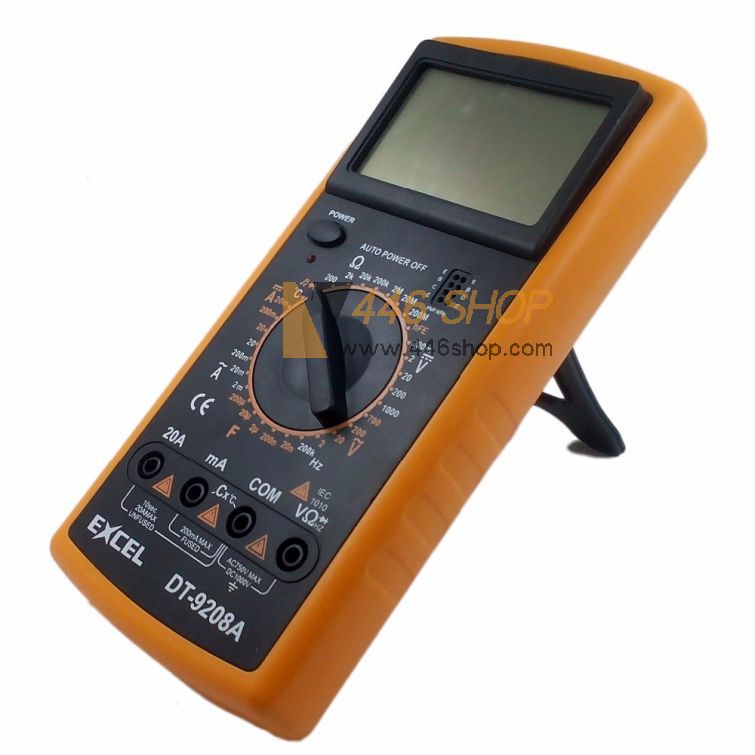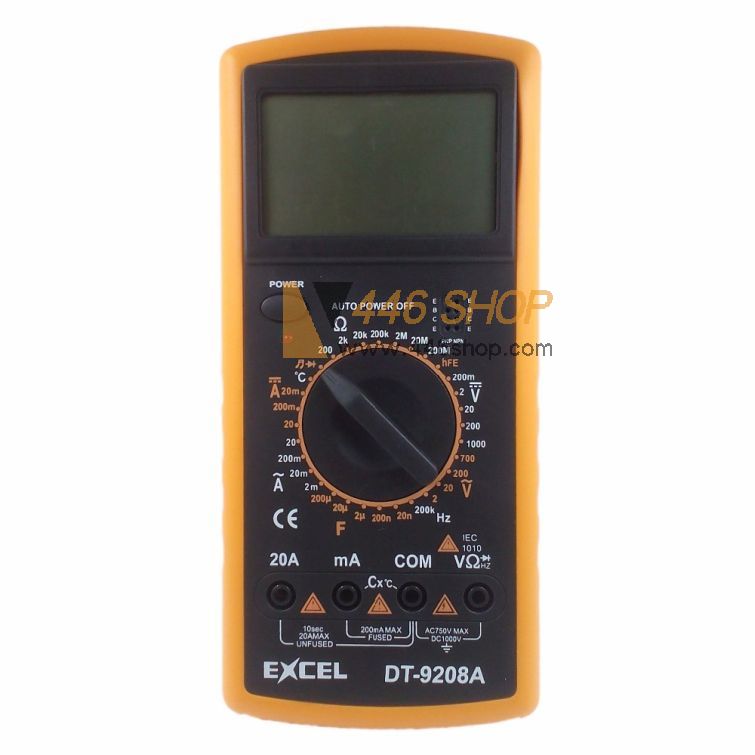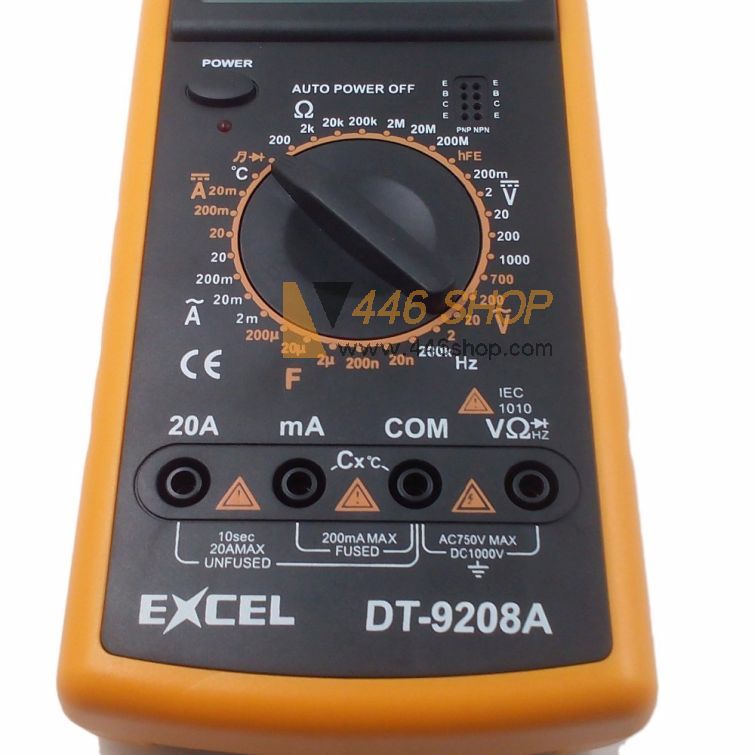EXCEL DT9208A Digital Multimeter DC AC Voltage Current
Resistance Capacitance Temperature Tester
1. INIRODUCTION
This instrument is compact, rugged, battery
operated, handheld 3 1/2digit digital.
multimeter for measuring DC and AC
voltage, DC and AC current, Resistance and
Diode, Capacitance, Transistor, continuity
Test and temperature or frequency
The Dual-slope A - D Converter uses C - MOS
technology for auto - zeroing, polarity
Selection and over - range indication Full
overload protection is provided. It is an
Ideal instrument for use in the field,
laboratory, workshop, hobby and home
applications.
2.FEATURES
Push-button ON-OFF
power switch.
Single 30 position
easy to use rotary switch for FUNCTION and RANGE
Selection
High sensitivity of
100µ V.
Automatic overrange
indication with the “1”displayed.
Automatic polarity
indication on DC ranges.
All ranges fully
protected.
Resistance
measurements 0.1Ω to 200MΩ.
Capacitance measurements
1 pF to 20µ F.
Diode testing with 1mA
fixed current.
Transistor hFE Test
With ib -100µA.
Temperature
measurement with or without K type thermocouple.
3.SPECIFICATIONS
Accuracies are ± (%reading + No. of
digits).
Gurranteed for 1 year, 23C±5C, less than
75%RH.
DC Voltage
|
RANGE
|
ACCURACY
|
RESOLUTION
|
|
200mV
|
±0.5%. of rdg ±5 digit
|
100µ V.
|
|
2V
|
1mV
|
|
20V
|
10mV
|
|
200V
|
100mV
|
|
1000V
|
±0.8% of rdg ±2 digit
|
5 V
|
Input Impedance: 10M ohm on all
ranges.
Overload Protection: 1000V dc , or peak ac
on all ranges.
AC Voltage
|
RANGE
|
ACCURACY
|
RESOLUTION
|
|
200mV
|
±1.2% .of rdg ± 3 digits
|
100µV
|
|
2V
|
±0.8%.of rdg ± 3 digits
|
1mV
|
|
20V
|
10mV
|
|
200V
|
100mV
|
|
700V
|
±1.2%.or rdg ± 3 digits
|
1V
|
Input Impedance: 10M ohm on all.
ranges. .
Frequency Renge: 40Hz to 400Hz.
Overload Protection: 750V rms or 1000V peak
continuous on ac ranges, except.
200mV ac range (15 seconds maximum above
300V rms)
Indication: Average (rms of sine
wave)
DC Current
|
RANGE
|
ACCURACY
|
RESOLUTION
|
|
2mA
|
± 1.2%,or rdg ± 5 digit
|
1µA.
|
|
20mA
|
10µ A
|
|
200mA
|
± 1.2%,or rdg ± 5digits
|
100µ A
|
|
20A
|
± 2%,or rdg ± 5digits
|
10mA
|
Overload protection: 0.2/250V fuse.(20A
range not fused)
Maximum. lnput Current: 20A, 15
sec.
AC CYRREBT
|
RANGE
|
ACCURACY
|
RESOLUTION
|
|
20mA
|
± 1.2%,or rdg ± 3digits
|
10µ A
|
|
200mA
|
± 2.0%,of rdg ± 3digits
|
100µ A
|
|
20A
|
± 3%,of rdg ± 7digits
|
10mA
|
Overload Protection: 0.2A/250V fuse.(20A
range not fused.)
Frequency Range: 40Hz to 400Hz.
Maximum Input Current: 20A 15 sec.
Indication: Average (rms of sine wave.)
Resistance
|
RANGE
|
ACCURACY
|
RESOLUTION
|
|
200 ohm
|
± 0.8% ,of rdg ± 3 digits
|
0.1 ohm
|
|
2K ohm
|
± 0.8% ,of rdg ± 1 digits
|
1 ohm
|
|
20K ohm
|
10 ohm
|
|
200K ohm
|
100 ohm
|
|
2M ohm
|
1k ohm
|
|
20M ohm
|
± 1% ,of rdg ± 2 digits
|
10k ohm
|
|
2000M ohm
|
±5% ,of (rdg -10 digits) ± 10 digits
|
100k ohm
|
On 200M ohm range, if short the two test
leads, display reading is 10
digits, this 10digits should be subtracted
from measurement results.
Capacitance
|
RANGE
|
ACCURACY
|
RESOLUTION
|
|
2000pF
|
± 2.5% ,of rdg ± 5 digits
|
1 PF
|
|
20nF
|
10 PF
|
|
200nF
|
100 PF
|
|
2µ F
|
1 nF
|
|
20µ F
|
10 nF
|
|
200µ F
|
± 5% ,of rdg ± 5 digits
|
|
Temperature
|
RANGE
|
TEMPERATURE RAGE
|
ACCURACY
|
RESOLUTION
|
|
T
|
-50C -400C
|
±0.75% of rdg ± 3C
|
1C
|
|
400 C -1000 C
|
±1.5% of rdg ± 15C
|
1C
|
|
0C -40C
|
±2 C
|
1C
|
Using T type thermocouple probe
Build - in temperature sensor.
Frequency Test
|
Range
|
Accuracy
|
Resolution
|
|
200KHz
|
± 1% of rdg ± 1 dight
|
100Hz
|
Overload Protection: A C 220 Vrms.
4. GENERAL CHARACTERISTICS
Maximum.
Display
: 1999 counts (3 1/2digits)with automatic.
polarity indication and eng .unit.
Indication
Method
: LCD display.
Measuring Method
:
Dual -Slope integration A - D converter
system
Overrange Indication
:”1”Figure
only in the display.
Maximum common mode
voltage : 500V dc/ac rms.
Reading
rate
:2-3 reading per sec (approximate) .
Temperature for guaranteed
accuracy :23C to± 5C.
Temperature
Ranges
:Operating 0C to 40C,32° F to.
104° F Storage -10C to 50C,14° F to122° F.
Power
Supply
:One 9 - volt battery (NEDA 1604 6F22
TYPE or equivalent ).
Low Battery Indication
:
to
left of display
Size
:88W
× 170D ×38H m/m
Weight
:
340g (including 9 volt batteries)
Accessories
:Operating manual. Set of test leads
Optional Accessories
:Thermocouple
(k type,400C) .
Spare fuse (200mA/250V fast below type).
9V Battery (Zinc- Carbon type)(no battery)
Soft Carring case.
5. OPERATION
1. Check the
9 - volt battery by setting the ON - OFF switch to ON. If the battery is
weak,a sign will appear on the
display.
It this does not appear on the display,
proceed as below. See MAINTENANCE if
the battery has to be replaced .
2. The mark,
or sign, next to the test lead jacks, is for warning
that the in-
put voltage or current should not exceed
the indicated values.
This is to prevent demage to the internal
circuity.
3. The
function switch should be set to the range which you want to test before
operation
4. If the voltage or current range is not
known beforehand set the FUNCTION
switch to a high range and work
down.
5. When only the figure “1”is displayed,
over range is being indicatea and the
FUNCTION switch must be set to a
higher range .
5.1) DC Voltage Measurement
1.Connect the BLACK test lead to the COM
jack and the .RED test lead to the V/Ωjack.
2. Set the FUNCTION switch to the V=range
to be used and connect the test
leads across the source or load
under measurement.
The polarity of the RED lead connection
will be indicated at the same time as the voltage.
Note:
Do not apply
more than 1000v to the input .Indication is possible at
higher voltages but there is danger of
damaging the internal circuitry
5.2) AC Voltage Measurement
1.Connect the BLACK test lead to the COM
jack and the RED test lead to the V/Ωjack.
2. Set the FUNCTION switch to the V- range
to be used and connect the test
leads across the source or load under
measurement.
Note:
Do not apply
more than700 rms the input .Indication is possible at
higher voltages but there is danger of
damaging the internal circuitry
5.3)DC Current Measurement
1.Connect the BLACK test lead to the COM
jack and the RED test lead to the
mA jack for a Maximum of
200mA.For a maximum of 20A,move the red test lead to
the 20A jack .
2.Set the FUNCTION switch to the A - range
to be used and connect the test leads in
series with the load under measurement .The
polarity at the RED test lead connection
will be indicated at the same time as the
current.
Note:
The Maximum
input current is 200mA ,or 20A depending on the jack used .
Excessive current will blow the fuse which
must be replaced .The 20A range is not
protected by protected by a fuse .The fuse
rating should be 200mA and no more to
prevent damage to the internal circuitry
.The Maximum terminal voltage drop is 200mV.
5.4)AC Current Measurement
1.Connect the BLACK test
lead to the COM jack and the RED test lead to the
mA jack for a maximum of
200mA.For a maximum of 20A,move the RED test lead to
the 20A jack .
2.Set the FUNCTION switch to the A - range
to be used and connect the test leads in
series with the load under measurement .
Note:
The Maximum
input current is 200mA ,or 20A depending upon the jack used .
Excessive current will blow the fuse which
must be replaced .The 20A Range is not
protected by a fuse .The fuse rating should
be 200mA and no more to prevent damage
to the internal circuitry .
The Maximum terminal voltage drop is 200mV.
5.5)Resistance Measurement
1.Connect the BLACK test lead to the COM
jack and the RED test lead to the
V/Ωjack.(Note: The polarity of the RED test
lead is “+”)
2.Set the FUNCTION switch to the Ω range to
the be used and connect the test
leads across the resistance under
measurement.
Note:
1. If the resistance
value being measured exceeds the maximum value of the range
selected an over -range indication will be
displayed (“1”) Select a higner range .For
resistance of approximately 1 megohm and
above , the Meter may take a few
seconds to become stable. This is normal
for high resistance readings.
2. When the
input is not connected, i. e. at open circuit ,the figure”1”will be displayed
for the over range condition.
3. When
checking in - circuit resistance, be sure circuit under test has all power
removed and that all capacitors are fully
discharged.
4.200MΩ range open circuit voltage is
3V.Display reading is 10 digits .when test
leads short ,this normal, when measure 10MΩ
resistor (on 200MΩ range).display
is 20.measure 100Mohm (on 200M range)display
reading is 110.The 10 digits is
a constant and should be subtracted from
the reading.
5.6)Capacitance Measurements
1. Before connecting the test capacitor
,note the display which may have readings
other than zero each time the
range is changed .This offset reading will not at
fect the accuracy for it can
be overridden by true value.
2.Connect the test capacitor to the input
sockets (not test leads) noting the polarity
connections when required.
Note:
1.When test individual capacitors insert
the eads into the two sockets, with”+”(upper
socket) ,”-” (Lower socket) ,at the
left of the pannel .(Capacitors should be
discharged before being inserted into
the test -jack).
2.When testing polarized capacitors, for
example, the tantalum type, particular
attention must be paid to the polarity
connections, This is to prevent possible
damage to the capacitor
When testing large capacitances, note that
there will be a certain time lag before the
final indication.
Units 1 pF =10-6µF InF
=10-3µF
. Do not connect an external voltage
or a charged capacitor (especially larger
capacitors) to the measuring terminals.
5.7)Diode Measurement and Continuity
Test
1.Connect the BLACK test lead to the COM
jack and the RED test lead to the V/Ωjack
(Note: The polarity of the RED test lead is
“+”).
2.Set the FUNCTION switch to the
range and connect the test leads across the diode
under measurement, display shows the
approx forward voltage of this diode.
3.Connect the test leads to two points of
circuit ,if the resistance is lower than approx 30Ω
Buzzer sounds.
5.8) Transistor hFE Test
1.Set, the FUNCTION switch to the hFE
range.
2.Datermine whether the transistor is NPN
or PNP and locate the Emitter Base and collector
leads into the proper holes in the
socket on the front panel.
3.The display will read the approximate hFE
value at the test condition Base Current 10µ A
VCE 2.8V.
5.9) Temperature Measurement
1.Measure temperature with K type
thermocouple, Set the FUNCTION switch to the T range
and insert the K type thermocouple
plug into KPROBE socket
2.Measure ambient temperature without probe
.On the same T range. display reading
is the ambient temperature in C.
5.10)Frequency test
1.Connect test Leads or shield cable to COM
and F/V/Ωjack.
2.Set the FUNCTION switch to KHZ range ,and
connect test leads or cable across the
source or load under measurement .
Note:
1.
Do not apply more than 220Vrms to the input ,indication is possible at voltage
voltage higher than 10Vrms ,but readings may
be out of specification.
2.In noisy environment it is preferable
to use shield cable for measuring small signal.
5.11)Auto Power -off (Optional Function)
Automatic Power-off extends the life of the
battery by turning the meter off if no
rotary function switch is operated for
about 15 min .The meter turns back on if either
the rotary switch is turned or the power
switch is pressed again
6.MAINTENANCE
Battery and /or fuse replacement
should only be done aner the test leads have been
disconnected and POWER OFF
6.1)9-Volt Battery Replacement
Note the condition of the 9- volt battery
using the procedure described above .if the
battery needs to be replaced, open the back
cover remove the spent battery and replace it
with a battery of the same type.
6.2)Fuse Replacement
Should the fuse need replacement use only
200mA fuses identical in physical size to
the original



| 
